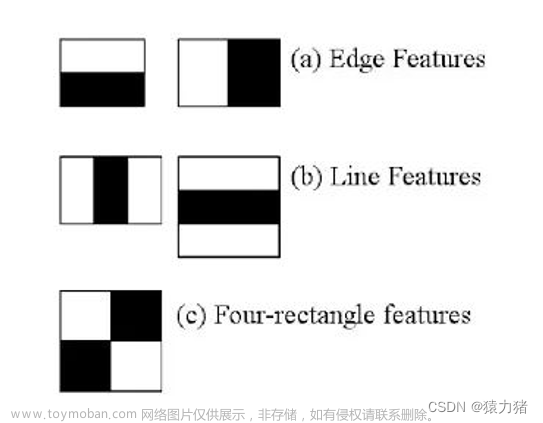1. 原理
我们都知道,yolo这些深度学习检测算法都是在python下用pytorch或tf框架这些训练的,训练得到的是pt或者weight权重文件,这些是算法开发人员做的事情,如何让算法的检测精度更高、速度更快。
但在工程化的时候,一般还是要用C++实现的,OpenCV不只是能进行图像的基本处理(以前我太肤浅了),它还有很多能处理深度学习的模块,比如DNN模块就支持调用多种框架下训练的权重文件。
下面就在VS2017+OpenCV454环境下进行演示。可以选择4种yolo变体,可以检测图片或视频。
(代码参考这位博主,以下是集成和演示)
2. 图片检测程序
运行代码前,请先配置好VS和OpenCV环境,然后准备好yolo相关权重文件(cfg+weight)。
首先定义yolo.h头文件:
#include <fstream>
#include <sstream>
#include <iostream>
#include <opencv2/dnn.hpp> //调用dnn模块
#include <opencv2/imgproc.hpp>
#include <opencv2/highgui.hpp>
using namespace cv;
using namespace dnn;
using namespace std;
//结构体定义:网络配置参数
struct Net_config
{
float confThreshold; // 置信度阈值
float nmsThreshold; // 非极大值抑制(重叠率)阈值
int inpWidth;
int inpHeight;
string classesFile; //类别文件名
string modelConfiguration; //模型配置文件
string modelWeights; //模型权重
string netname; //模型名称
};
//定义yolo类
class YOLO
{
public:
YOLO(Net_config config);
void detect(Mat& frame); //检测函数
private:
float confThreshold; //类别置信度阈值
float nmsThreshold; //重叠率阈值
int inpWidth; //图片宽度
int inpHeight; //图片高度
char netname[20]; //网络名称
vector<string> classes; //存储类别的数组
Net net; //深度学习模型读取
void postprocess(Mat& frame, const vector<Mat>& outs); //后处理函数
void drawPred(int classId, float conf, int left, int top, int right, int bottom, Mat& frame); //画框
};
//定义网络数组
Net_config yolo_nets[4] = {
{0.5, 0.4, 416, 416,"coco.names", "yolov3/yolov3.cfg", "yolov3/yolov3.weights", "yolov3"},
{0.5, 0.4, 608, 608,"coco.names", "yolov4/yolov4-tiny.cfg", "yolov4/yolov4-tiny.weights", "yolov4-tiny"},
{0.5, 0.4, 320, 320,"coco.names", "yolo-fastest/yolo-fastest-xl.cfg", "yolo-fastest/yolo-fastest-xl.weights", "yolo-fastest"},
{0.5, 0.4, 320, 320,"coco.names", "yolobile/csdarknet53s-panet-spp.cfg", "yolobile/yolobile.weights", "yolobile"}
};
然后进入main主程序:
#include "yolo.h"
//网络配置构造函数
YOLO::YOLO(Net_config config)
{
cout << "Net use " << config.netname << endl;
this->confThreshold = config.confThreshold;
this->nmsThreshold = config.nmsThreshold;
this->inpWidth = config.inpWidth;
this->inpHeight = config.inpHeight;
strcpy_s(this->netname, config.netname.c_str());
ifstream ifs(config.classesFile.c_str());
string line;
while (getline(ifs, line)) this->classes.push_back(line);
this->net = readNetFromDarknet(config.modelConfiguration, config.modelWeights);
this->net.setPreferableBackend(DNN_BACKEND_OPENCV);
this->net.setPreferableTarget(DNN_TARGET_CPU);
}
//后处理
void YOLO::postprocess(Mat& frame, const vector<Mat>& outs) // Remove the bounding boxes with low confidence using non-maxima suppression
{
vector<int> classIds; //类别
vector<float> confidences; //置信度
vector<Rect> boxes; //框
for (size_t i = 0; i < outs.size(); ++i)
{
// Scan through all the bounding boxes output from the network and keep only the
// ones with high confidence scores. Assign the box's class label as the class
// with the highest score for the box.
float* data = (float*)outs[i].data;
for (int j = 0; j < outs[i].rows; ++j, data += outs[i].cols)
{
Mat scores = outs[i].row(j).colRange(5, outs[i].cols);
Point classIdPoint;
double confidence;
// Get the value and location of the maximum score
minMaxLoc(scores, 0, &confidence, 0, &classIdPoint);
//当置信度大于阈值
if (confidence > this->confThreshold)
{
int centerX = (int)(data[0] * frame.cols);
int centerY = (int)(data[1] * frame.rows);
int width = (int)(data[2] * frame.cols);
int height = (int)(data[3] * frame.rows);
int left = centerX - width / 2;
int top = centerY - height / 2;
classIds.push_back(classIdPoint.x);
confidences.push_back((float)confidence);
boxes.push_back(Rect(left, top, width, height));
}
}
}
// Perform non maximum suppression to eliminate redundant overlapping boxes with
// lower confidences
vector<int> indices;
NMSBoxes(boxes, confidences, this->confThreshold, this->nmsThreshold, indices);
for (size_t i = 0; i < indices.size(); ++i)
{
int idx = indices[i];
Rect box = boxes[idx];
this->drawPred(classIds[idx], confidences[idx], box.x, box.y,
box.x + box.width, box.y + box.height, frame);
}
}
//画预测框
void YOLO::drawPred(int classId, float conf, int left, int top, int right, int bottom, Mat& frame) // Draw the predicted bounding box
{
//Draw a rectangle displaying the bounding box 画框
rectangle(frame, Point(left, top), Point(right, bottom), Scalar(0, 0, 255), 3);
//Get the label for the class name and its confidence 打标签
string label = format("%.2f", conf);
if (!this->classes.empty())
{
CV_Assert(classId < (int)this->classes.size());
label = this->classes[classId] + ":" + label;
}
//Display the label at the top of the bounding box 展示标签
int baseLine;
Size labelSize = getTextSize(label, FONT_HERSHEY_SIMPLEX, 0.5, 1, &baseLine);
top = max(top, labelSize.height);
//rectangle(frame, Point(left, top - int(1.5 * labelSize.height)), Point(left + int(1.5 * labelSize.width), top + baseLine), Scalar(0, 255, 0), FILLED);
putText(frame, label, Point(left, top), FONT_HERSHEY_SIMPLEX, 0.75, Scalar(0, 255, 0), 1);
}
//detect检测
void YOLO::detect(Mat& frame)
{
Mat blob; //blob预处理
blobFromImage(frame, blob, 1 / 255.0, Size(this->inpWidth, this->inpHeight), Scalar(0, 0, 0), true, false);
this->net.setInput(blob);
vector<Mat> outs;
this->net.forward(outs, this->net.getUnconnectedOutLayersNames()); //前向处理
this->postprocess(frame, outs); //后处理
vector<double> layersTimes;
double freq = getTickFrequency() / 1000;
double t = net.getPerfProfile(layersTimes) / freq;
string label = format("%s Inference time : %.2f ms", this->netname, t);
putText(frame, label, Point(0, 30), FONT_HERSHEY_SIMPLEX, 1, Scalar(0, 0, 255), 2);
//imwrite(format("%s_out.jpg", this->netname), frame);
}
//main入口
int main()
{
YOLO yolo_model(yolo_nets[2]); //选择网络
//1.图片检测
string imgpath = "dog.jpg";
Mat srcimg = imread(imgpath); //读取照片
yolo_model.detect(srcimg); //调用检测程序
//图片检测界面
static const string kWinName = "Deep learning object detection in OpenCV C++";
namedWindow(kWinName, WINDOW_NORMAL);
imshow(kWinName, srcimg);
waitKey(0);
destroyAllWindows();
}
运行结果如下:

3. 视频检测程序
要调用视频,只需在main函数中加入:
//2.视频检测/实时摄像头
VideoCapture capture("test.avi"); //0
Mat frame;
while (true) {
int ret = capture.read(frame);
if (!ret) {
break;
}
//imshow("input", frame); //显示原视频
yolo_model.detect(frame); //调用process
static const string kWinName = "Deep learning object detection in OpenCV C++";
namedWindow(kWinName, WINDOW_NORMAL);
imshow(kWinName, frame);
char c = waitKey(5);
if (c == 27) {
break;
}
}
运行结果如下:

其他
还有一个用SSD MobileNet检测的示例:
项目Github地址:https://github.com/ChiekoN/OpenCV_SSD_MobileNet
#编译
mkdir build && cd build
cmake ..
make
./ssd_obj_detect
基于ROS的人脸检测的示例:
项目Github地址:https://github.com/1417265678/robot_vision
# 先起相机节点
roslaunch robot_vision usb_cam.launch
# 检测节点
roslaunch robot_vision face_detector.launch
 文章来源:https://www.toymoban.com/news/detail-614946.html
文章来源:https://www.toymoban.com/news/detail-614946.html
以上。文章来源地址https://www.toymoban.com/news/detail-614946.html
到了这里,关于【OpenCV】基于OpenCV/C++实现yolo目标检测的文章就介绍完了。如果您还想了解更多内容,请在右上角搜索TOY模板网以前的文章或继续浏览下面的相关文章,希望大家以后多多支持TOY模板网!












